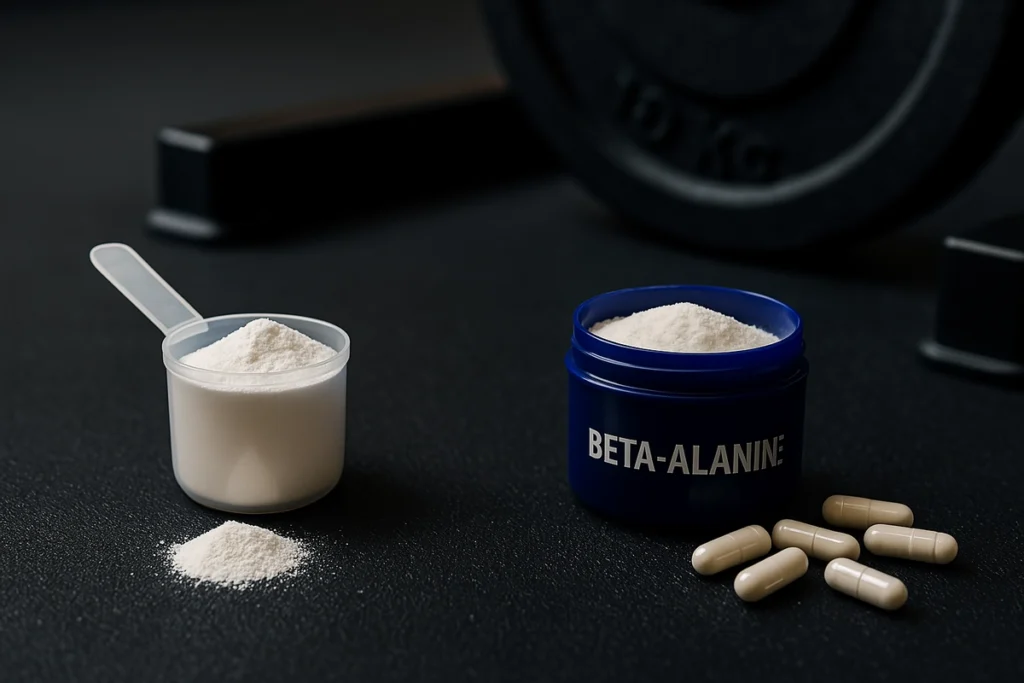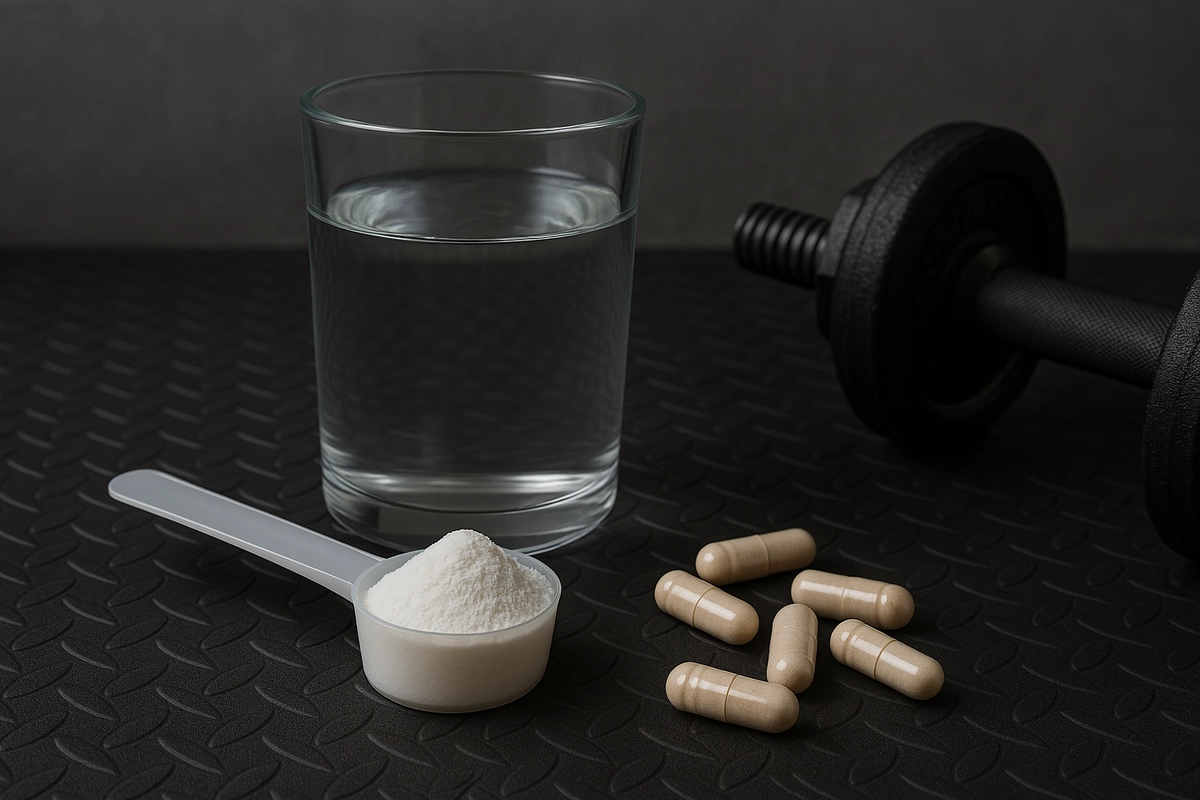You’ll usually start feeling the performance benefits of beta-alanine after about 2 to 4 weeks of consistent daily use. Peak effects typically show up after 4 to 8 weeks, once your muscle carnosine levels have significantly increased.
This isn’t a supplement that hits instantly like caffeine. It’s a long-term player — and it rewards consistency and hard work.
Table of contents
What Exactly Is Beta-Alanine?

Beta-alanine is a non-essential amino acid that boosts carnosine levels in your muscles. Why does that matter? Because carnosine helps buffer the acid that builds up during intense training — the same burning sensation that forces you to drop the bar or stop sprinting before you’re mentally ready.
So, what beta-alanine really gives you is more time under tension, more reps, and more intensity — especially in workouts where you’re pushing hard.
I learned this firsthand years ago when I was training for a high-rep squat challenge. I was already dialed in with creatine and caffeine, but beta-alanine was new to my stack. By week 4, I noticed I could hit 15–20 reps without my quads locking up in lactic acid. That was a breakthrough.
How Beta-Alanine Improves Performance
Beta-alanine really shines during:
- High-rep resistance training
- Supersets and drop sets
- HIIT sessions
- Explosive sports like MMA or CrossFit
One of my clients, a female athlete in her 30s training for her first amateur boxing match, struggled with fatigue halfway through our mitt drills. I introduced beta-alanine into her plan, and by the 5th week, she could go through three full rounds of pads at fight pace — without needing a breather between each.
This wasn’t magic — it was biology. Her muscles could buffer acid better, and that translated into real-world stamina.
Why It Doesn’t Work Immediately
This is one of the most common misunderstandings.
Beta-alanine needs to build up in your system. Think of it like slowly filling a gas tank — not like flipping a switch. It increases your intramuscular carnosine levels, and that takes time.
A friend of mine, also a fitness coach, once texted me: “Bro, I took beta-alanine for 3 days and felt nothing. Waste of money?”
My reply?
“Call me in 4 weeks.”
Sure enough, a month later, he was smashing high-volume leg days without needing extended rest between sets. Trust the process.
How to Take Beta-Alanine for Best Results

Here’s what I recommend to my clients — and what I do myself:
- Daily dose: 3.2–6.4 grams
- Split doses (e.g., 2g morning, 2g pre-workout, 2g post-workout) to reduce tingling
- Take it every day, not just training days
To get the most out of beta-alanine, timing and consistency matter — even though the exact hour you take it isn’t critical. If you’re wondering about the best time to take beta-alanine for optimal performance and reduced side effects, I’ve covered that in detail in a separate guide. It helps you build a routine that sticks, especially if you’re stacking supplements or training multiple times a week.
And yes — that tingling sensation (called paresthesia) is totally normal and harmless. It happens more at higher doses. If it bothers you, split the dose.
Funny story: one of my male clients panicked the first day he tried it. He messaged me saying, “Man, I think I’m allergic! My arms are buzzing.”
I laughed and told him: “Congrats, it’s working. That’s the beta-alanine handshake.”
When You Might Start Noticing Results
Here’s a rough timeline, based on real-world use with dozens of clients over the years:
- Week 1: Tingling kicks in (maybe), but no noticeable performance changes yet
- Weeks 2–3: Slight boost in endurance and recovery between sets
- Weeks 4–6: Workouts feel “lighter” — you can push harder for longer
- Weeks 6–8: Full benefits realized — noticeable improvement in muscular stamina, volume, and work capacity
One of my online clients, a busy dad training 4 days a week at home, kept detailed logs. He told me after week 5 that he could complete his entire upper body circuit without needing extra rest between supersets — something he couldn’t manage earlier, even with pre-workout.
Tips from My Coaching Experience
I’ve used beta-alanine myself for years and recommended it to clients ranging from competitive athletes to everyday lifters. Here’s what I’ve learned:
Who Benefits Most:
- Athletes doing moderate to high-volume resistance training
- Fighters or HIIT enthusiasts who do interval-style conditioning
- Lifters in cutting phases needing endurance under fatigue
Common Mistakes:
- Expecting it to feel like caffeine or creatine
- Taking it inconsistently
- Giving up before week 4
I remember a client who quit using it after 10 days, saying it wasn’t “doing anything.” I convinced him to restart and give it another 3 weeks. By week 5, he hit a PR in his CrossFit WOD volume — 3 full rounds more than usual. He never looked back.
If you’re serious about building both strength and muscular endurance, combining supplements can give you an edge. One of my favorite strategies — both personally and for clients — is using a creatine and beta-alanine stack. These two work differently but complement each other well, and I’ve broken down exactly how to stack them safely and effectively in this detailed post.
Should You Take It? Final Thoughts
✅ Take beta-alanine if:
- You train hard, sweat heavy, and want to fight fatigue
- You already have your training and diet dialed in
- You’re chasing performance — not just “a pump”
❌ Skip it if:
- You’re doing light cardio, yoga, or low-effort workouts
- You’re inconsistent with training or supplements
- You hate the idea of delayed gratification
Final Words from a Coach Who Lives This Life
Beta-alanine isn’t flashy — and that’s exactly why many people overlook its power.
But as a coach who’s seen it work dozens of times, I can tell you: if you’re training with intensity, chasing progress, and committed to showing up day after day, beta-alanine will help you push past your limits.
It’s not for everyone. But for those who live the grind — it’s a valuable tool in your arsenal.
Train hard. Supplement smart. And trust the process.



Leave a Reply